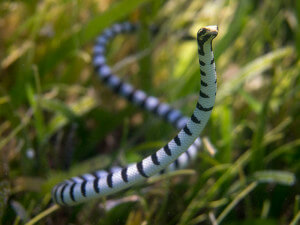
Another sea snake mimic?
Scientists, by training, are all about skepticism. It is an important part of the scientific process to believe false until proven true. This approach ensures that hypotheses are not easily accepted, and puts the focus on the method and statistics rather than observations and belief. It also forces scientists to rigorously test and retest their hypothesis.A recent article in BBC reported that scientists from Australia hypothesized that juvenile zebra sharks (Stegostoma fasciatum) mimic sea snakes (see here: http://www.bbc.com/earth/story/20150502-the-shark-that-looks-like-a-snake). The color pattern certainly fits and the model it is mimicking possesses one of the more potent venoms in the world. In their presentation for why they believe this is true, the two most important observations, for me, do not hold a tremendous amount of weight. Please let me state that I am not in absolute disagreement, just skeptical.
Their first point revolved around the body shape and swimming motions of the zebra shark. Though I will argue why I don’t think these reasons suggest it is mimicking the sea snake are entirely valid, I will freely admit that this point is easily the stronger of the two. The elongated tail without the presence of a significant lower tail lobe makes it appear to be ‘snake-like’ in appearance but it also could just be a function of their lifestyle; both as juveniles and as adults. Zebra sharks spend most of the lives lying on the bottom. It makes good sense that their tail fin be elongated and without a lower lobe. Having a high upper tail lobe would be cumbersome and, in areas with current, act as an unnecessary sail. It may also attract unwanted attention. At the same time, having a lower lobe would ultimately interfere with the dynamics of lying on the bottom. If it is nearly as equal in length to the upper tail lobe (as is the case with many sharks), it might be awkward and undoubtedly uncomfortable. This design seems entirely natural to accommodate a sedentary lifestyle. I do admit that the extra long tail is ‘snake-like’ and if it were proven that these sharks do, in fact, mimic sea snakes then this would be their strongest point.
The second point was that juveniles spend time in shallow areas around mangroves and sea grass, similar to habitats that sea snakes can be found. This follows the usual observation that mimics dwell in similar areas as their model because in the absence of the model, the rouse does not work. As a snorkel and dive guide for well over a decade, I often find myself in these habitats. Sea grass and mangroves, for example, are a regular part of our tour programs and I have spent hundreds of hours in each. I have yet to see a juvenile zebra shark. For example, I worked in Palau for three years. I regularly saw adult zebra sharks (Ngedebus Coral Gardens, almost a guarantee) but I never did see a juvenile (and easily spent as much time on shallow reefs, around mangroves and in sea grass habitats). Many of my friends have way more time in Palau than I did and they, too, are yet to see one. It can be argued that they are cryptic and I have just been missing them. Okay, fair enough, but it is my observation and understanding that mimics are not usually cryptic. Rather there are often exposed because of their mimicry. Furthermore, it is my understanding that juvenile zebra sharks spend much of their early life in deeper water where they can hide more effectively from predators like other sharks. Anyone want to weigh in here?
Finally, let me be clear that my observations are limited with regards to juvenile zebra sharks. The only photo I have is the one used as the header for this blog and this was taken at an aquarium where it was born in captivity. I could easily be wrong here and would not mind if I was. As a student of science my training led me to be skeptical, but also to accept the conclusions that a well designed, well executed experiment can reveal. When the peer-reviewed paper comes out describing this relationship between the zebra shark and sea snake, I will gladly embrace it and post the link :-)!


